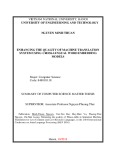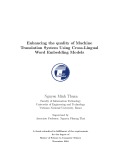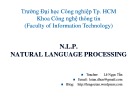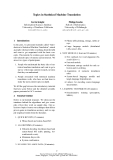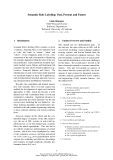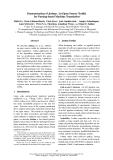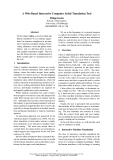
Machine translation
-
Mục tiêu nghiên cứu của luận văn là vận dụng kiến thức đã học để xây dựng một hệ thống trả lời tự động, sử dụng mạng học sâu Deep Neural Networks, dựa trên khung làm việc sequence-to-sequence và cơ chế attention để sinh ra câu trả lời tự động từ một chuỗi đầu vào tương ứng. Mô hình được huấn luyện end-to-end GNMT (Google’s Neural Machine Translation) trên tập dữ liệu miền mở có sẵn.
 72p
72p  matroinho2510
matroinho2510
 08-11-2022
08-11-2022
 57
57
 17
17
 Download
Download
-
The purpose of this thesis is to propose two models for using cross-lingual word embedding models to address the above impediment. The first model enhances the quality of the phrase-table in SMT, and the remaining model tackles the unknown word problem in NMT.
 14p
14p  tamynhan0
tamynhan0
 04-07-2020
04-07-2020
 27
27
 3
3
 Download
Download
-
The purpose of this thesis is to propose two models for using cross-lingual word embedding models to address the above impediment. The first model enhances the quality of the phrase-table in SMT, and the remaining model tackles the unknown word problem in NMT.
 54p
54p  tamynhan0
tamynhan0
 04-07-2020
04-07-2020
 16
16
 5
5
 Download
Download
-
Lecture “Natural language processing – Chapter 5: Foundation of statistical machine translation” has contents: Introduction to statistical machine translation, statistical MT systems, three problems in statistical MT systems, translation model, and other contents.
 12p
12p  dien_vi01
dien_vi01
 21-11-2018
21-11-2018
 23
23
 1
1
 Download
Download
-
In the past, we presented tutorials called “Introduction to Statistical Machine Translation”, aimed at people who know little or nothing about the field and want to get acquainted with the basic concepts. This tutorial, by contrast, goes more deeply into selected topics of intense current interest. We aim at two types of participants: 1. People who understand the basic idea of statistical machine translation and want to get a survey of hot-topic current research, in terms that they can understand. 2.
 1p
1p  hongphan_1
hongphan_1
 15-04-2013
15-04-2013
 64
64
 3
3
 Download
Download
-
Semantic Role Labeling (SRL) consists of, given a sentence, detecting basic event structures such as “who” did “what” to “whom”, “when” and “where”. From a linguistic point of view, a key component of the task corresponds to identifying the semantic arguments filling the roles of the sentence predicates. Typical predicate semantic arguments include Agent, Patient, and Instrument, but semantic roles may also be found as adjuncts (e.g., Locative, Temporal, Manner, and Cause).
 1p
1p  hongphan_1
hongphan_1
 15-04-2013
15-04-2013
 55
55
 2
2
 Download
Download
-
We describe Joshua (Li et al., 2009a)1 , an open source toolkit for statistical machine translation. Joshua implements all of the algorithms required for translation via synchronous context free grammars (SCFGs): chart-parsing, n-gram language model integration, beam- and cubepruning, and k-best extraction. The toolkit also implements suffix-array grammar extraction and minimum error rate training. It uses parallel and distributed computing techniques for scalability.
 4p
4p  hongphan_1
hongphan_1
 15-04-2013
15-04-2013
 48
48
 2
2
 Download
Download
-
We developed caitra, a novel tool that aids human translators by (a) making suggestions for sentence completion in an interactive machine translation setting, (b) providing alternative word and phrase translations, and (c) allowing them to postedit machine translation output. The tool uses the Moses decoder, is implemented in Ruby on Rails and C++ and delivered over the web. We are at the beginning of a research program to explore the benefits of these different types of aid to human translators, analyze user interaction behavior, and develop novel types of assistance. ...
 4p
4p  hongphan_1
hongphan_1
 15-04-2013
15-04-2013
 66
66
 2
2
 Download
Download









